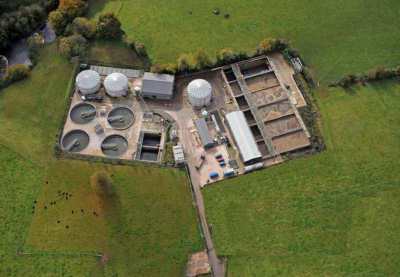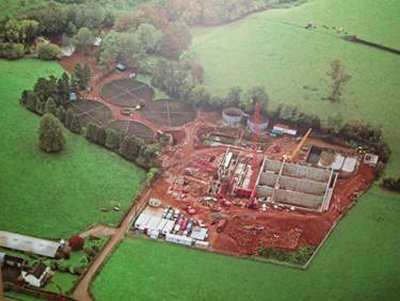Cookstown Wastewater Treatment Works get CEEQUAL rating of Very Good
Overview

Northern Ireland Water has helped a local river agency to restore the natural beauty of one of their most respected watercourses by incorporating a series of river improvement measures into the construction of its new Cookstown Wastewater Treatment Works (WwTW).
The new Cookstown WwTW represents a £13m investment by Northern Ireland Water to upgrade the existing treatment processes and bring the standard of discharge to the Ballinderry River into line with the latest European directives. The modern Cookstown WwTW was designed and built with the upmost respect and appreciation for the surrounding area and as a result was awarded a CEEQUAL (now known as BREEAM Infrastructure) rating of Very Good.
About

Northern Ireland Water (NI Water) is the main water company in Northern Ireland. The company provides 575 million litres of clean water a day for almost 1.8 million people.
Background
The Upper Ballinderry River is a Special Area of Conservation; an Area of Special Scientific Interest and one of the most important rivers in Northern Ireland for rare aquatic species. Not content with designing a new works that would simply comply with wastewater standards, the project team wanted to go one step further and put to rights some of the damage that had been exerted on the Lower Ballinderry through the poor quality of effluent which historically had been released to the watercourse from numerous sources.
Challenges
Over the years the quality of the water in the Lower Ballinderry River had deteriorated due to the operational failings of the old works. Built in 1965, this works was only designed for a population of 11,500 (about one third of the area’s current population) and until the commissioning of the new works it had been unable to cope with the growing pressures put upon it. As the works became increasingly overloaded, the declining quality of the discharge began to have an adverse effect on the condition of the river and its inhabitants.
Solutions
As part of the plans to construct Cookstown’s new wastewater plant, NI Water’s project team – working closely with representatives from the Ballinderry River Enhancement Association (BREA) and the wider fishing fraternity – developed firm objectives to enhance the Ballinderry River and introduce new measures that would protect the river in the future. They included the following:
Design and construction
Built on the site of the existing sewage works, the new Cookstown WwTW has been designed to cater for a future population equivalent to 45,000 people. The modern hi-tech works adopts a sequential batch reactor (SBR) process – a compact footprint plant which does not require a separate secondary settlement stage – a process that would take up valuable space on a very restricted site.
Working within the confines of the existing site footprint, coupled with the need to keep the existing works live, was probably the biggest challenge that faced the construction team. The two-year project was carried out in phases with sections of the new plant being built and commissioned sequentially to allow portions of the existing plant to be taken off line.
This phased approach required meticulous planning and a constant flow of communications to ensure that operations at the old works were not affected by the construction and commissioning process.
Working in partnership with NI Water to construct the new works were: BSG Civil Engineering, Williams Industrial Services, Severn Trent Services and Doran Consulting.
Stakeholder liason
Prior to construction work getting underway, the project team set up a preliminary river improvement workshop, to offer a common platform for all those with an interest in the river, to come together to discuss their concerns and put forward ideas for enhancing the river quality and safeguarding its long-term protection.
During this initial workshop, NI Water highlighted how the design of the works had been developed with cognisance of the adjacent Ballinderry River explaining that an innovative new treatment process had been devised that would fit in with the existing works’ footprint so as not to disturb unnecessarily any ground around the site. The workshop proved a valuable exercise and from the outset of the scheme, provided a crucial stepping stone to building strategic links with some key project stakeholders. The knowledge gleaned from the BREA and the fishing clubs/agencies was fundamental in introducing the most effective river improvement methods without disturbing any of the existing fish or invertebrate life.
Environmental considerations
A full Environmental Management Plan was developed for the construction phase which included the use of a special ‘Siltbuster’ to filter groundwater and the implementation of dedicated washout bays for concrete lorries. To improve the conditions in the river and protect it from construction work in the short term, NI Water took the decision to carry out ancillary upgrades to the existing plant to temporarily raise the quality of the treatment process until the new works was brought on line and complied with current discharge consents.
River improvements
To the delight of the NI Water team, their joint venture contractors for the scheme, BSG Civil Engineering and Williams Industrial Services, wholeheartedly bought into the idea of improving the river. The following steps were taken ahead of construction:
All river banks were strengthened to prevent future erosion.
Weirs and groynes lying above and below the works were repaired using indigenous stone from the site.
A boom downstream of the works was introduced so that any silt or debris from the working site was caught and removed.
A number of gravel spawning beds were introduced at agreed locations to provide a healthy breeding habitat for migrating fish such as salmon and dollaghan.
In addition, a special aeration system was developed and introduced to the stretch of water running parallel to the works site. The purpose of this was to provide an artificial means of introducing air into the river to oxygenate the water at times of low flows. This unique aeration system was particularly welcomed by the fishing custodians as it has provided them with a long-term mitigation plan to deal with any future pollution which may occur upstream from the new works from any source.
Sustainability
To promote sustainability, all concrete and rock excavated during construction was crushed on site and used in the formation of hard standing areas around the new works, whilst large boulders unearthed were taken to the river and used in the building of weirs and groynes. Landscaping around the site was undertaken using native tree species.
In a bid to enhance the river corridor even further and encourage wildlife back to the area, the team joined forces with the Woodland Trust and Wildlife Trust to erect a series of bird and bat boxes along a two-mile stretch upstream of the works.
Benefits
The extensive environmental considerations and river improvement work that have gone into the construction of the new Cookstown WwTW are paying dividends for the area. Where once the fishing amenity of the area had been in decline due to the poor quality of the water, the river is now rich in myriad invertebrates previously unable to survive in the area and hosts an abundance of aquatic life.
Unique breeding programmes such as the Freshwater Pearl Mussel initiative have been greatly enhanced and the number of fish returning to the area is uncountable since the new works was commissioned.
Perhaps the following quote from Alan Keys of the Ballinderry Fish Hatchery best sums up the achievements made:
“The new sewage treatment plant has completely changed the river environment for about five miles downstream of Cookstown. The migratory spawning fish, such as the dollaghan and salmon, used to pass through the middle river and spawn upstream of Cookstown. Two farmers told me that they haven’t seen fish spawning at Killymoon and Ardtrea for 40 years. Over the past two winters, hundreds of big dollaghan have used the clean gravel and we have great counts of young trout here now”.
